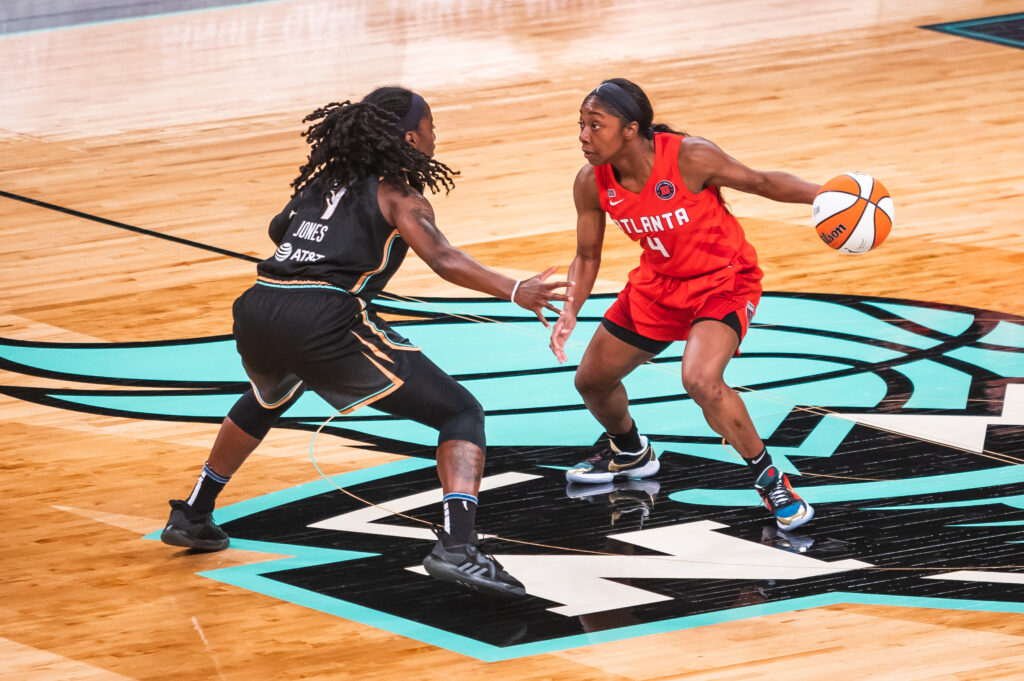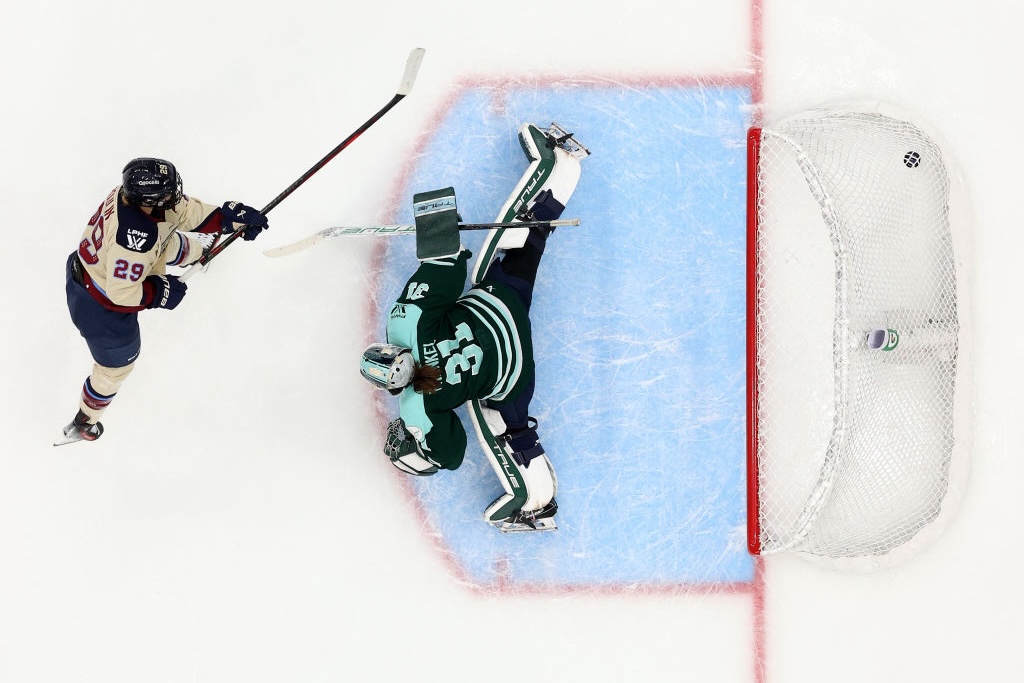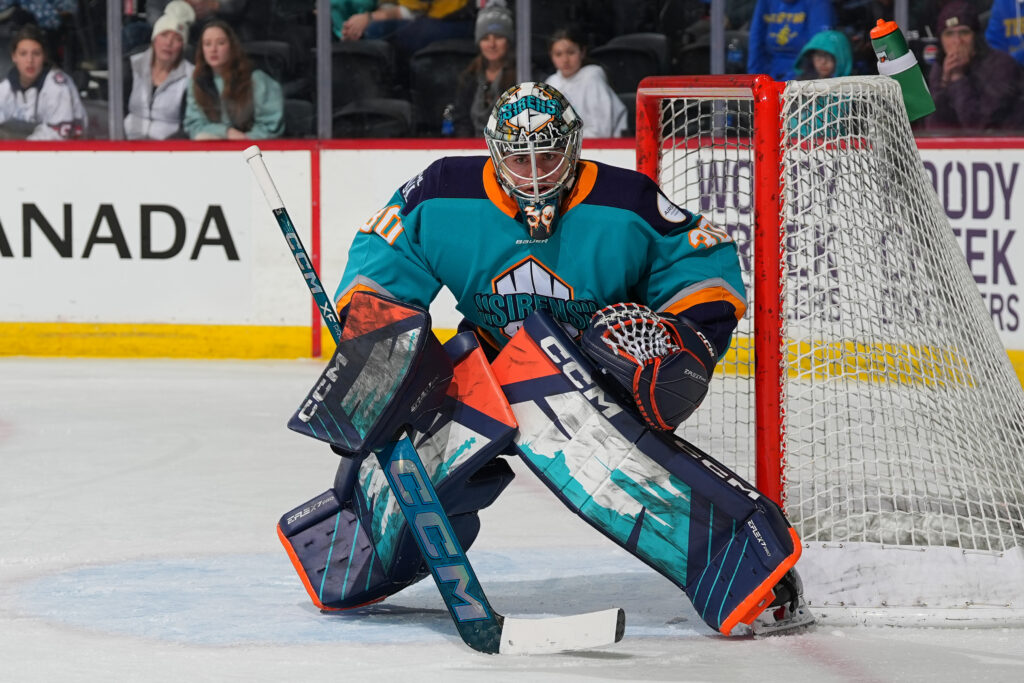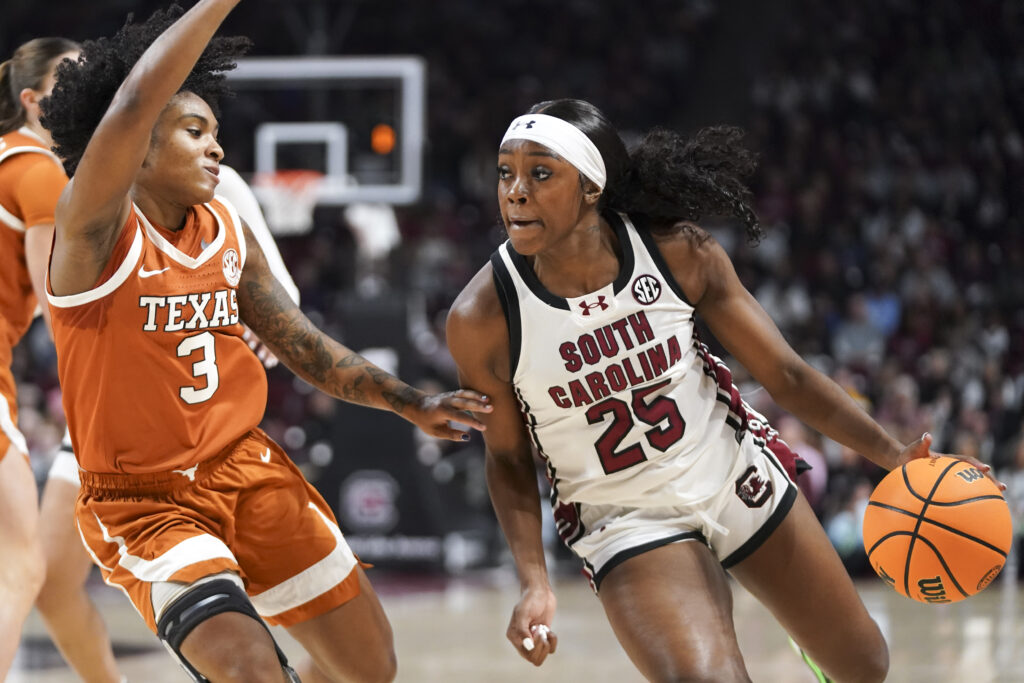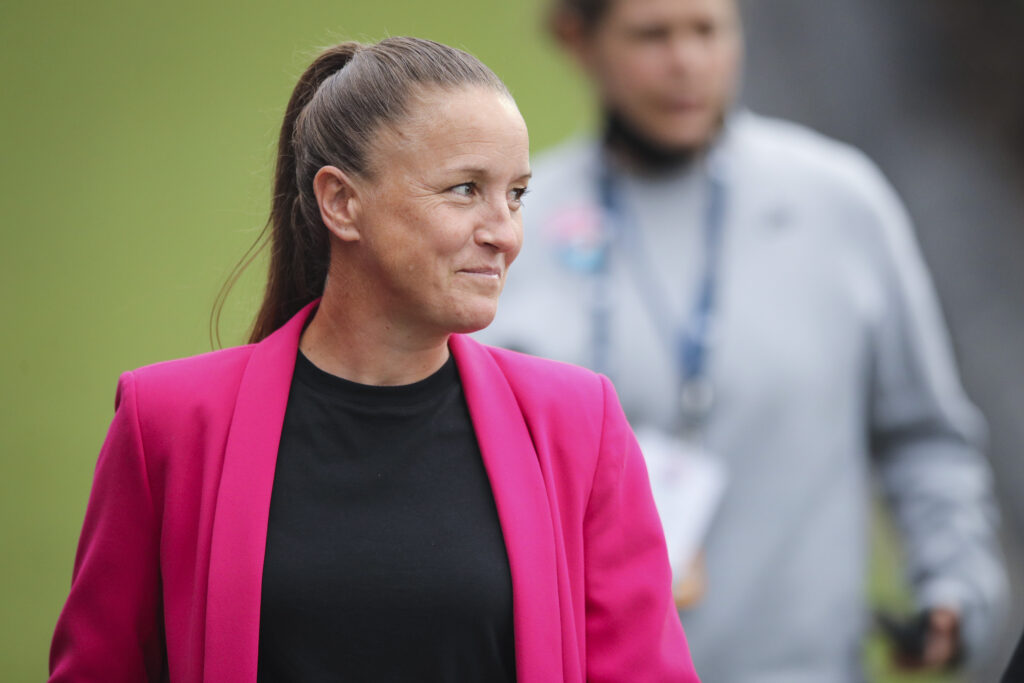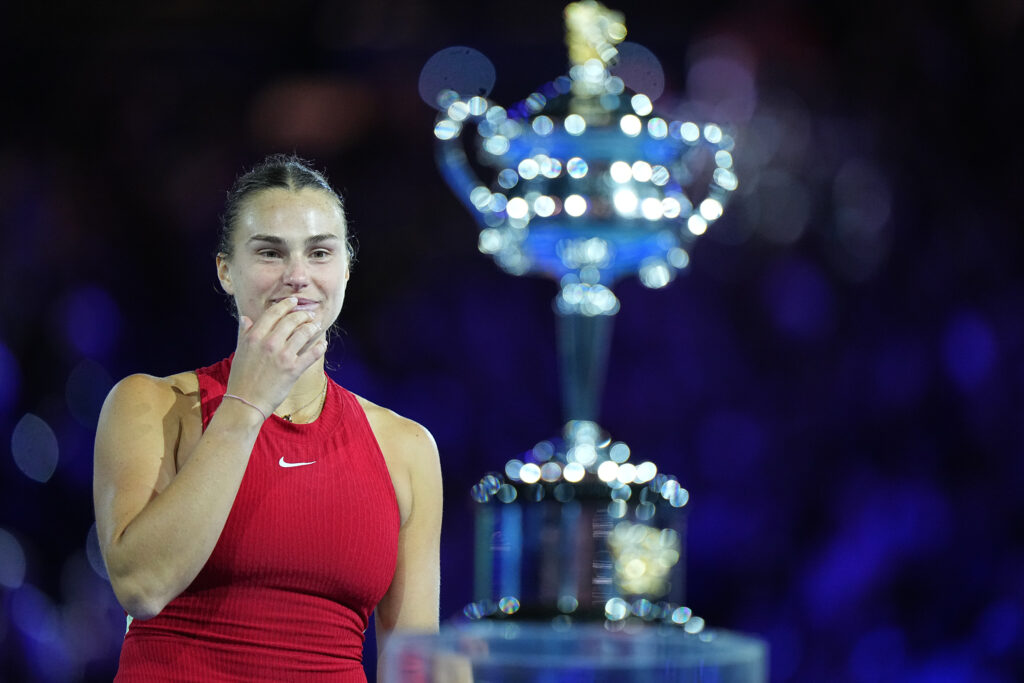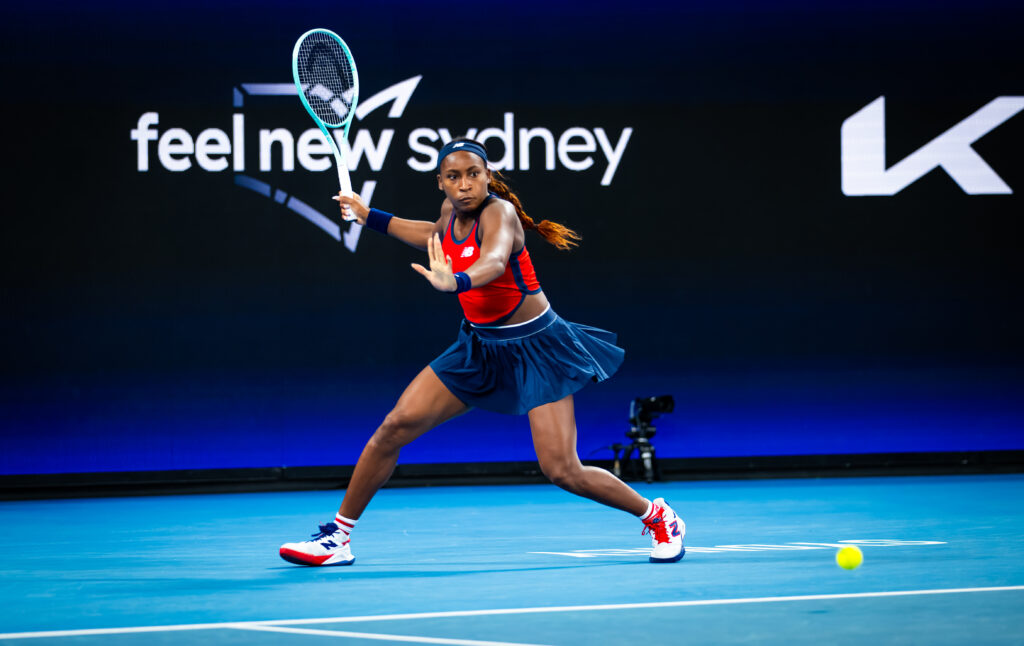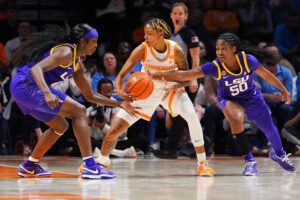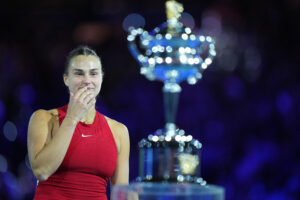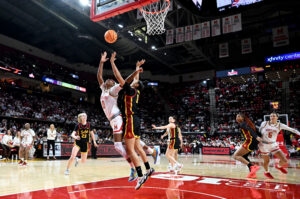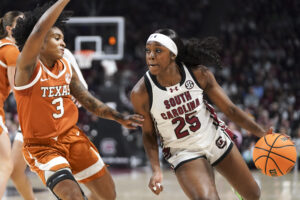On the night of the 2021 WNBA Draft in April, Destiny Slocum was sitting on her living room couch surrounded by family and friends as she waited for the televised announcement. She didn’t know exactly when or where she was going to get drafted, but she believed without a doubt that her name would be called.
The confirmation came early in the second round, when the Las Vegas Aces selected Slocum with the 14th overall pick and ESPN captured Slocum’s jubilant reaction.
“I think my entire life, especially coming from a small town like Boise, not many people thought that I would ever go to the WNBA,” said the former Arkansas point guard and first Boise-born player to be drafted into the WNBA. “I think just having that moment of everything that I’ve worked for … was a big thing for me.”
Once the reality set in that she was off to Las Vegas to play with reigning WNBA MVP A’ja Wilson and for head coach Bill Laimbeer, Slocum shifted her focus back to where it was before the draft. She would train and work hard to try to make the roster because she knew nothing was guaranteed, even as a draft pick.
There are 12 teams in the WNBA and only 144 roster spots available. In some cases, the salary cap limits a team to carry 11 players rather than the usual 12. This is the stark reality for every rookie who enters the league. The competition for a roster spot is extremely tough, especially for players drafted in the second and third rounds.
“I think the one thing about the WNBA is once you’re drafted, it only means so much, right? To me, I say it’s worth a penny of the entire dollar — you still have to make the team,” Slocum said. “You really have to shift your mindset in a lot of ways and get past the draft. Like, you really can’t enjoy draft night because you’re like, all right, now I gotta go and make this roster.”
Slocum arrived in Las Vegas with the mindset that the only way Laimbeer would cut her was because of salary cap restrictions. She would do everything in her power to show him why she was worthy of one of the 12 spots. That meant adjusting quickly to the speed and strength of players at the WNBA level.
“I mean, there’s really no jump. You go straight from college to the pros and that’s what they expect you to do, too,” Slocum said. “They hand you the playbook, you come back and you know the plays when (coach Laimbeer) calls them. Just a lot of responsibility and maturity comes with it.”
The Rook's first official points as an Ace!@DestinySlocum24 // #ALLIN ♦️♠️ pic.twitter.com/Uasi8ZxUUu
— Las Vegas Aces (@LVAces) May 22, 2021
The transition to the WNBA can be overwhelming for draft picks. Many of them have to adapt to bench-heavy roles after being their college team’s go-to player.
Aari McDonald can attest to that challenge. The Arizona point guard shot up WNBA mock draft boards after she led the Wildcats to the 2021 NCAA championship game against Stanford. Even though her team lost, McDonald was the star of the tournament. When the Atlanta Dream selected her third overall, McDonald celebrated with her family and then quickly moved on to the task at hand.
“I thought, OK, Chennedy [Carter], Courtney [Williams], Odyssey [Sims],” she said. “I was like, OK, this is gonna be fun.”
McDonald felt as if she were starting her freshman year all over again when she got to Atlanta. But her teammates, she says, made her feel right at home, consistently motivating her and offering advice that has made her stronger. McDonald has plenty of experienced players to learn from on a guard-heavy team.
Still, because of that depth chart at guard, the Dream’s move to take McDonald with the third pick was puzzling to some. In just the past year, the Dream had drafted Carter fourth overall and signed Sims in free agency. As a result, McDonald has averaged just 13.6 minutes per game this season, and before Carter was suspended in early July, she was playing even less.
“McDonald was surprising, not because she’s not talented but just because (Atlanta) is so loaded at point guard,” said a former WNBA assistant coach. “That one really was confusing to me. I figured they would get something they could use, that could help them. I understand them trying to load up with talent, but, like, she’s just sitting the bench for them because they have so many players who are ahead of her.”
“I’m not gonna lie to you, it’s hard,” McDonald said. “It’s a learning adjustment, but once my number’s called, I’m ready. It’s making me stronger. It’s making me hungry.”
Players drafted in the first round aren’t even guaranteed a place on a WNBA team. And if they prove they belong in training camp, their contract still might not fit within a team’s salary cap. For rookies selected in the latter half of the draft, the gap between the college basketball and WNBA levels can be too far to bridge.
Of the 36 players drafted in 2021, only 17 are currently listed as active players. Two first-round draft picks, Shyla Heal and Stephanie Watts, were waived before getting much of a chance to prove themselves. Chelsey Perry, drafted 26th overall by the Indiana Fever, was the only third-round draft pick to make a roster (she was initially waived and then re-signed with Fever later in the season).
The roster turnover among WNBA rookies has left some questioning the scouting and drafting process, and the challenges the pandemic presented this past year.
“Looking at this draft class … you didn’t know who could make an impact right away,” said the former assistant coach. “This is going to sound biased because she’s the one playing the best — I liked Michaela Onyenwere from UCLA. That was my favorite player in this draft. We didn’t know if anyone else would come out early, and COVID didn’t help that at all. I know Rhyne Howard was possibly coming out as well, but she obviously came back. Onyenwere was probably the top one.”
Onyenwere, drafted sixth overall by the New York Liberty, is the current frontrunner for Rookie of the Year. She has started every game this season and is averaging 23.8 minutes, 9.8 points and 2.9 rebounds per game. Onyenwere is the only rookie playing over 20 minutes per game this season, marking a considerable dropoff from last season when seven rookies who appeared in more than 15 games averaged over 20 minutes for their teams.

Curt Miller, head coach and GM of the Connecticut Sun, also had Onyenwere high on his draft board. But without a first-round pick in 2021, he knew she wouldn’t last until the second round. He also figured she would have been drafted earlier than sixth.
“I can only speak for us — it wasn’t the easiest preparation in what we were planning without a first round-draft pick,” Miller said. “I wasn’t as caught up as some of these teams were as far as the star power, the upper first-round picks or how that was all gonna play out. We didn’t concern ourselves as much with that this year as we would have if we had had a first-round draft pick.”
The toughest challenge for Miller and his staff was figuring out the best way to prepare for the draft while dealing with COVID-19.
“You didn’t know exactly who was going to come into the draft,” he said. “We are a staff that loves to be in person, and that was impossible. I love to not only attend games, but we love to attend practices in person. You learn so much more.”
Miller waited patiently as the draft unfolded, watching players slip and scratching his head at some of the players teams picked ahead of him. It became apparent that some teams were picking based on positional needs, while others were going with the best available player. Both strategies helped, he says, when it came time for the Sun to make their pick at No. 20.
DiJonai Carrington was a two-way prospect Miller liked from the start, and the Baylor guard dropped right into the Sun’s lap.
“We thought, behind the scenes and throughout our investigation, there were a significant amount of second-round picks that would be picked before us that would not stick on final rosters compared to our second-round pick, who had a real shot of making our roster because of our salary cap situation,” Miller said.
Indeed, Carrington stuck with Connecticut. Some analysts even predicted her to win Rookie of the Year. But so far this season, Carrington is averaging fewer than 10 minutes per game.
https://t.co/2eJYnozvxi pic.twitter.com/MWG6GtYrRY
— Connecticut Sun (@ConnecticutSun) July 3, 2021
Currently, the top five picks of the 2021 WNBA Draft — Charli Collier, Awak Kuier, McDonald, Kysre Gondrezick and Chelsea Dungee — are barely playing at all. Onyenwere plays the most. According to Miller, she landed in the perfect situation for her to succeed in New York.
When it comes to making it in the WNBA, fit means everything. Miller remembers acquiring Courtney Williams from the Phoenix Mercury nearly halfway through the 2016 season. Drafted eighth overall that year, Williams hadn’t played much in Phoenix. The guard thrived in three and a half seasons with the Sun and was named to her first All-Star team this year with the Dream.
“We traded for Courtney, who was averaging a point per game in Phoenix but thrived in our system,” Miller said. “Right system, right fit, right timing.”
The same questions can be asked this season. Would Onyenwere be playing just as well if Dallas had taken her with one of their top picks? If Collier had gone to New York, would she be thriving? Would McDonald have been better off sitting behind Courtney Vandersloot in Chicago?
To Slocum, landing in Las Vegas didn’t make sense at first. But after watching film and spending more time with the team, her perspective changed.
“I think I fit in the system well,” Slocum said. “My role is to get in there and give energy, pressure guards and knock down shots. For me, it’s been a good transition and a team I feel like I fit in pretty well with.”
Her Aces teammates — especially Riquna Williams, Slocum says — have welcomed her. And while she’s had to adjust to certain aspects of the WNBA game, Slocum’s basketball IQ has been an asset. The toughest lesson for her has been patience.
“I mean, you’re crazy if you’re a basketball player and you don’t want to be on the floor every second. But also, patience [is important] in everything you do,” she said. “I show up every day as if I’m going to play 40 minutes every game. It’s what I do with the minutes that I do have that are valuable. My biggest goal is, when I’m in the game, am I doing everything in my power to help us win?”

McDonald feels the same way.
“The biggest lesson I learned was to stay ready,” she said. “You never know what can happen, you never know when your number is called. But when it’s called, you gotta deliver. You gotta play your game.”
McDonald also thinks she ended up in the right place. She was shy at first but says there’s no way she can be anyone but herself on the Dream, a team that loves to have fun and goof around. McDonald has bonded with Sims, the veteran guard who tells her to just “do what has gotten you here” when she is on the court. It’s a lesson she’s taken to heart in the WNBA, where players have to prove every day that they belong.
“I think that when you’re on a team with similar players, iron sharpens iron,” McDonald said. “We’re making each other better every day in practice. We’re gonna put these pieces together, and we’re gonna fight and we’re gonna scrap and grind it out. And I really like my odds.”
